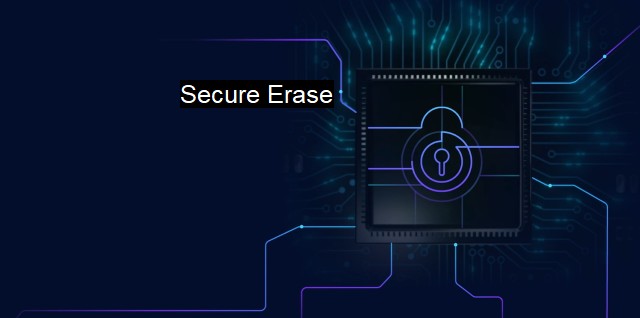What is Secure Erase?
Secure Erase Technology: Protecting Your Sensitive Data from Cyber Threats
Secure erase is a high concern aspect within the disciplines of data security, cybersecurity, and antivirus applications, and its essential contribution extends to providing an effective solution to permanently eliminate sensitive information present on various types of digital storage devices like hard drives and solid-state drives (SSDs). The definition might sound similar to the conventional 'delete' function, yet a secure erase is a technically unique process, fundamentally different from and superior to normal file or data removal.In a conventional delete operation, the operating system marks the data spaces as 'available to rewrite,' rather than completely eliminating the contents. The files deleted in this manner continue to reside in the memory until they're overwritten by other files. This retention implies that advanced recovery software can retrieve supposedly 'deleted' files, leading to potential breaches of sensitive data or critical information.
In contrast, secure erase is a method that extends beyond just marking spaces and proceeds to entirely wipe clean or 'sanitize' the data storage areas involved. It goes a step further to overwrite memory spaces with other data, effectively ensuring that the original information becomes eternally irretrievable. This comprehensive erasure provides assurance that unique identifiers or critical data of the previous user cannot be recovered or exploited consequent to the secure erasure procedure.
Secure erase capability is innately included in most hard disk drives (HDDs) and solid-state drives (SSDs) as part of the specifications defined by various standard organizations like the National Institute of Standards and Technology (NIST). Importance of secure erasure becomes vital when recycling, reselling, or disposing of old hard drives to essentially shield individuals, corporates or organizations from potential data leaks and misuse.
The method of secure erasure could be classified into various techniques, with significant variations in the sophistications and security levels provided.
Software-based Secure Erase is the primary technique where specific programs conduct multiple overwrites on the data space. The popular Gutmann method employed in erasure software, for instance, implements a stringent 35 pass procedure to induce randomized patterns, although, it is more applicable to older hard discs. Modern hard discs need fewer passes for secure erasure, predominantly attributed to advancement in technology. in some industries, a strict protocol of data eradication is implicit, therefore multi-pass techniques may still hold importance.
The second highlighting technique involves firmware-based Secure Erase which directly employs commands ingrained in the drive firmware. This method poses an efficient mechanism over software-based erasure as it works on the entire drive, including remapped sectors within its firmware.
Secure erase puts the user at an advantageous position in maintaining their cybersecurity posture. While it essentially mitigates data leakage or exposure from end-of-life storage devices, it also caters to incidental situations; for instance, if a malware is heavy-embedded within the system, a secure erase can often be the eventual option for complete eradication of virus traces.
Implementing secure erase could be a pivotal tool against potential cyber attacks or unauthorized data recuperation. Regardless, it is essential to facilitate a data backup before conducting secure erase, as it removes all contents, including precious work files, personal photos, or essential data. Regardless of the operation's specific method or drive type, the ultimate goal of secure erase stays uniform – irretrievable elimination of storage data to resist any potential misuse.
To summarize, securely erasing data transcends beyond the plain scope of data removal or wiping, while playing a pivotal role in maintaining hard-won cybersecurity. Amidst an era of rising cyber threats, it can serve to be a vital act in the frontline defense against data intrusions and unauthorized misuse.

Secure Erase FAQs
What is secure erase?
Secure erase is a process that completely removes all data on a storage device, making it unrecoverable by any means. This process ensures that sensitive information is not accessible by unauthorized persons.Why is secure erase important?
Secure erase is important because it helps prevent data breaches and protects sensitive information from falling into the wrong hands. It ensures that data is fully erased and unrecoverable, providing an extra layer of protection against cyber attacks.What are the benefits of using secure erase?
The benefits of using secure erase include protecting sensitive data from being accessed by unauthorized persons, reducing the risk of data breaches, and complying with data protection regulations. Secure erase also ensures that data is permanently erased, which can also improve device performance.How does secure erase differ from a standard delete or format?
Secure erase differs from a standard delete or format by completely wiping all data on a storage device, making it unrecoverable. A standard delete or format may leave behind remnants of the data, which may still be recoverable. Secure erase uses specialized algorithms and techniques to ensure that all data is erased and can never be recovered.| | A | | | B | | | C | | | D | | | E | | | F | | | G | | | H | | | I | | | J | | | K | | | L | | | M | |
| | N | | | O | | | P | | | Q | | | R | | | S | | | T | | | U | | | V | | | W | | | X | | | Y | | | Z | |
| | 1 | | | 2 | | | 3 | | | 4 | | | 7 | | | 8 | | |||||||